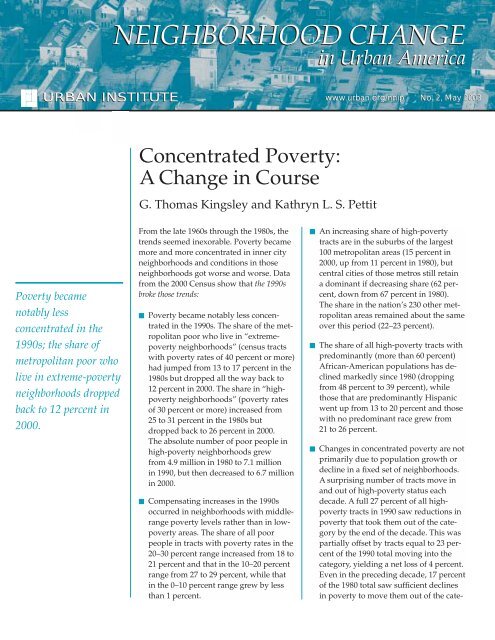Concentrated Poverty
Concentrated Poverty
Concentrated Poverty
Create successful ePaper yourself
Turn your PDF publications into a flip-book with our unique Google optimized e-Paper software.
NEIGHBORHOOD CHANGE<br />
in Urban America<br />
URBAN INSTITUTE www.urban.org/nnip No. 2, May 2003<br />
<strong>Concentrated</strong> <strong>Poverty</strong>:<br />
AChange in Course<br />
G. Thomas Kingsley and Kathryn L. S. Pettit<br />
<strong>Poverty</strong> became<br />
notably less<br />
concentrated in the<br />
1990s; the share of<br />
metropolitan poor who<br />
live in extreme-poverty<br />
neighborhoods dropped<br />
back to 12 percent in<br />
2000.<br />
From the late 1960s through the 1980s, the<br />
trends seemed inexorable. <strong>Poverty</strong> became<br />
more and more concentrated in inner city<br />
neighborhoods and conditions in those<br />
neighborhoods got worse and worse. Data<br />
from the 2000 Census show that the 1990s<br />
broke those trends:<br />
<strong>Poverty</strong> became notably less concentrated<br />
in the 1990s. The share of the metropolitan<br />
poor who live in “extremepoverty<br />
neighborhoods” (census tracts<br />
with poverty rates of 40 percent or more)<br />
had jumped from 13 to 17 percent in the<br />
1980s but dropped all the way back to<br />
12 percent in 2000. The share in “highpoverty<br />
neighborhoods” (poverty rates<br />
of 30 percent or more) increased from<br />
25 to 31 percent in the 1980s but<br />
dropped back to 26 percent in 2000.<br />
The absolute number of poor people in<br />
high-poverty neighborhoods grew<br />
from 4.9 million in 1980 to 7.1 million<br />
in 1990, but then decreased to 6.7 million<br />
in 2000.<br />
Compensating increases in the 1990s<br />
occurred in neighborhoods with middlerange<br />
poverty levels rather than in lowpoverty<br />
areas. The share of all poor<br />
people in tracts with poverty rates in the<br />
20–30 percent range increased from 18 to<br />
21 percent and that in the 10–20 percent<br />
range from 27 to 29 percent, while that<br />
in the 0–10 percent range grew by less<br />
than 1 percent.<br />
An increasing share of high-poverty<br />
tracts are in the suburbs of the largest<br />
100 metropolitan areas (15 percent in<br />
2000, up from 11 percent in 1980), but<br />
central cities of those metros still retain<br />
a dominant if decreasing share (62 percent,<br />
down from 67 percent in 1980).<br />
The share in the nation’s 230 other metropolitan<br />
areas remained about the same<br />
over this period (22–23 percent).<br />
The share of all high-poverty tracts with<br />
predominantly (more than 60 percent)<br />
African-American populations has declined<br />
markedly since 1980 (dropping<br />
from 48 percent to 39 percent), while<br />
those that are predominantly Hispanic<br />
went up from 13 to 20 percent and those<br />
with no predominant race grew from<br />
21 to 26 percent.<br />
Changes in concentrated poverty are not<br />
primarily due to population growth or<br />
decline in a fixed set of neighborhoods.<br />
Asurprising number of tracts move in<br />
and out of high-poverty status each<br />
decade. A full 27 percent of all highpoverty<br />
tracts in 1990 saw reductions in<br />
poverty that took them out of the category<br />
by the end of the decade. This was<br />
partially offset by tracts equal to 23 percent<br />
of the 1990 total moving into the<br />
category, yielding a net loss of 4 percent.<br />
Even in the preceding decade, 17 percent<br />
of the 1980 total saw sufficient declines<br />
in poverty to move them out of the cate-

















